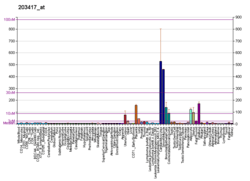MFAP2
| MFAP2 | |||||||||||||||||||||||||
|---|---|---|---|---|---|---|---|---|---|---|---|---|---|---|---|---|---|---|---|---|---|---|---|---|---|
| Identifiers | |||||||||||||||||||||||||
| Aliases | MFAP2, MAGP, MAGP-1, MAGP1, microfibrillar associated protein 2, microfibril associated protein 2 | ||||||||||||||||||||||||
| External IDs | MGI: 99559 HomoloGene: 1801 GeneCards: MFAP2 | ||||||||||||||||||||||||
| |||||||||||||||||||||||||
| |||||||||||||||||||||||||
| |||||||||||||||||||||||||
| Orthologs | |||||||||||||||||||||||||
| Species | Human | Mouse | |||||||||||||||||||||||
| Entrez | |||||||||||||||||||||||||
| Ensembl | |||||||||||||||||||||||||
| UniProt | |||||||||||||||||||||||||
| RefSeq (mRNA) | |||||||||||||||||||||||||
| RefSeq (protein) | |||||||||||||||||||||||||
| Location (UCSC) | Chr 1: 16.97 – 16.98 Mb | Chr 4: 141.01 – 141.02 Mb | |||||||||||||||||||||||
| PubMed search | [3] | [4] | |||||||||||||||||||||||
| Wikidata | |||||||||||||||||||||||||
| |||||||||||||||||||||||||
Microfibrillar-associated protein 2 is a protein that in humans is encoded by the MFAP2 gene.[5][6]
Microfibrillar-associated protein 2 is a major antigen of elastin-associated microfibrils and a candidate for involvement in the etiology of inherited connective tissue diseases. This gene encodes two transcripts with two alternatively spliced 5' untranslated exons. These two transcripts contain the same 8 coding exons, and therefore, encode the same protein.[6]
References
- 1 2 3 GRCh38: Ensembl release 89: ENSG00000117122 - Ensembl, May 2017
- 1 2 3 GRCm38: Ensembl release 89: ENSMUSG00000060572 - Ensembl, May 2017
- ↑ "Human PubMed Reference:".
- ↑ "Mouse PubMed Reference:".
- ↑ Faraco J, Bashir M, Rosenbloom J, Francke U (Jun 1995). "Characterization of the human gene for microfibril-associated glycoprotein (MFAP2), assignment to chromosome 1p36.1-p35, and linkage to D1S170". Genomics. 25 (3): 630–7. doi:10.1016/0888-7543(95)80004-6. PMID 7759096.
- 1 2 "Entrez Gene: MFAP2 microfibrillar-associated protein 2".
Further reading
- Gibson MA, Hughes JL, Fanning JC, Cleary EG (1986). "The major antigen of elastin-associated microfibrils is a 31-kDa glycoprotein". J. Biol. Chem. 261 (24): 11429–36. PMID 3015971.
- Maruyama K, Sugano S (1994). "Oligo-capping: a simple method to replace the cap structure of eukaryotic mRNAs with oligoribonucleotides". Gene. 138 (1–2): 171–4. doi:10.1016/0378-1119(94)90802-8. PMID 8125298.
- Brown-Augsburger P, Broekelmann T, Rosenbloom J, Mecham RP (1996). "Functional domains on elastin and microfibril-associated glycoprotein involved in elastic fibre assembly". Biochem. J. 318 (1): 149–55. PMC 1217601. PMID 8761465.
- Finnis ML, Gibson MA (1997). "Microfibril-associated glycoprotein-1 (MAGP-1) binds to the pepsin-resistant domain of the alpha3(VI) chain of type VI collagen". J. Biol. Chem. 272 (36): 22817–23. doi:10.1074/jbc.272.36.22817. PMID 9278443.
- Suzuki Y, Yoshitomo-Nakagawa K, Maruyama K, et al. (1997). "Construction and characterization of a full length-enriched and a 5'-end-enriched cDNA library". Gene. 200 (1–2): 149–56. doi:10.1016/S0378-1119(97)00411-3. PMID 9373149.
- Fujimoto N, Tajima S, Ishibashi A (2000). "Expression of microfibril-associated glycoprotein-1 (MAGP-1) in human epidermal keratinocytes". Arch. Dermatol. Res. 292 (1): 21–6. doi:10.1007/PL00007456. PMID 10664011.
- Trask BC, Broekelmann T, Ritty TM, et al. (2001). "Posttranslational modifications of microfibril associated glycoprotein-1 (MAGP-1)". Biochemistry. 40 (14): 4372–80. doi:10.1021/bi002738z. PMID 11284693.
- Jensen SA, Reinhardt DP, Gibson MA, Weiss AS (2001). "Protein interaction studies of MAGP-1 with tropoelastin and fibrillin-1". J. Biol. Chem. 276 (43): 39661–6. doi:10.1074/jbc.M104533200. PMID 11481325.
- Reinboth B, Hanssen E, Cleary EG, Gibson MA (2002). "Molecular interactions of biglycan and decorin with elastic fiber components: biglycan forms a ternary complex with tropoelastin and microfibril-associated glycoprotein 1". J. Biol. Chem. 277 (6): 3950–7. doi:10.1074/jbc.M109540200. PMID 11723132.
- Segade F, Trask BC, Broekelmann TJ, et al. (2002). "Identification of a matrix-binding domain in MAGP1 and MAGP2 and intracellular localization of alternative splice forms". J. Biol. Chem. 277 (13): 11050–7. doi:10.1074/jbc.M110347200. PMID 11796718.
- Strausberg RL, Feingold EA, Grouse LH, et al. (2003). "Generation and initial analysis of more than 15,000 full-length human and mouse cDNA sequences". Proc. Natl. Acad. Sci. U.S.A. 99 (26): 16899–903. doi:10.1073/pnas.242603899. PMC 139241. PMID 12477932.
- Werneck CC, Trask BC, Broekelmann TJ, et al. (2004). "Identification of a major microfibril-associated glycoprotein-1-binding domain in fibrillin-2". J. Biol. Chem. 279 (22): 23045–51. doi:10.1074/jbc.M402656200. PMID 15044481.
- Clarke AW, Weiss AS (2004). "Microfibril-associated glycoprotein-1 binding to tropoelastin: multiple binding sites and the role of divalent cations". Eur. J. Biochem. 271 (14): 3085–90. doi:10.1111/j.1432-1033.2004.04246.x. PMID 15233806.
- Gerhard DS, Wagner L, Feingold EA, et al. (2004). "The status, quality, and expansion of the NIH full-length cDNA project: the Mammalian Gene Collection (MGC)". Genome Res. 14 (10B): 2121–7. doi:10.1101/gr.2596504. PMC 528928. PMID 15489334.
- Rual JF, Venkatesan K, Hao T, et al. (2005). "Towards a proteome-scale map of the human protein-protein interaction network". Nature. 437 (7062): 1173–8. doi:10.1038/nature04209. PMID 16189514.
- Miyamoto A, Lau R, Hein PW, et al. (2006). "Microfibrillar proteins MAGP-1 and MAGP-2 induce Notch1 extracellular domain dissociation and receptor activation". J. Biol. Chem. 281 (15): 10089–97. doi:10.1074/jbc.M600298200. PMID 16492672.
- Gregory SG, Barlow KF, McLay KE, et al. (2006). "The DNA sequence and biological annotation of human chromosome 1". Nature. 441 (7091): 315–21. doi:10.1038/nature04727. PMID 16710414.
This article is issued from
Wikipedia.
The text is licensed under Creative Commons - Attribution - Sharealike.
Additional terms may apply for the media files.




